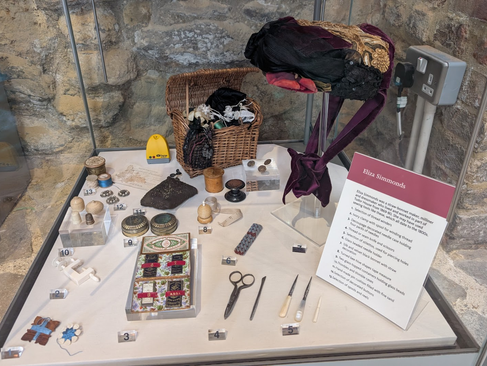Southampton: The Tudor House and Garden
- chirp54
- May 29
- 3 min read
Being a history buff, it was obvious that I had to visit the Tudor House and Garden which was, handily, located about two blocks from our rental. The building is impossible to miss and looks very much like a Tudor building.

It is, in fact, a great deal older than that. The earliest part of the site is a Norman dwelling known as King John's Palace - more about that later. After paying our entrance fee, we were ushered into the Banqueting Hall and were greeted by the house's ghosts in an audiovisual presentation. It sounds a bit gimmicky, but it was really well done. The room was in darkness, allowing different parts of the room to be illuminated when their history was being discussed.

When the presentation was over, the curtains opened,

we left the banqueting hall, and moved on to the Tudor Knot Garden, which was exquisite.



On the far side of the garden, a stone arch led to King John's Palace.


It's an enormous, and enormously impressive, site built in the 1180s.
In 1338, the French and Italians raided Southampton, burning buildings, slaughtering locals, and pillaging expensive and important goods from the town and docks. After the raid, King Edward III ordered the city to build walls to surround the entire city. The doors and windows of King John's Palace were blocked with stone and it became part of the city's defenses.
In 1491, Sir John Dawtrey joined three cottages together to create the Tudor House as we know it today. Dawtrey was a major landowner, MP, and Sheriff who received large sums of money from Henry VIII to supply food for the navy and to help in the defenses of the town. On the walkway above King John's Palace, there's a magnificent bronze cannon made for Henry VIII in 1542.
In the sixteenth and seventeenth centuries the house was used as a merchant house. Among the merchants who lived here were Henry Cawte, a bookbinder, and Eliza Simmonds, who made hats. Tools like those they might have used were on display in the work room.
In the next rooms were kitchens. The first illustrates what a Tudor kitchen would have looked like. The signs here and around the house are made with lenticular prints which change when you move from one side to the other. Here's an example:
It's so clever. On the other side of the wall from the Tudor kitchen, is a Victorian kitchen.

You can see that the Victorian fireplace was inserted into where the much larger Tudor fireplace stood. (Note the curved beam above it.)
There's wonderful signage all around the house which explains a lot about how the inhabitants and their servants lived. One such sign said that servants in smaller households didn't have their own rooms and often had to sleep in cupboards or under the stairs! In addition to the signage, you can opt to use an audio guide, which we did. The narrations were informative and really entertaining. I highly recommend it when you visit.
The Georgian room features a collection of paintings with a Southampton theme and offers a wonderful view of the Tudor Knot Garden.

Throughout the house there are bits of graffiti - very old graffiti. Here are two examples of witch marks:


During the restoration in 2007, conservators discovered that several walls were covered with graffiti that dated to between 1570 and 1620.

Speaking of the restoration, there's a wonderful film in the Explorer room that details how the restoration was accomplished. So much care had to be taken to preserve the walls which were starting to buckle under the additional weight added when earlier changes to the house were made. Each owner had altered it to reflect the latest fashions and to make it more luxurious. The bits of the house that had to be replaced during the 21st century renovation were done in an incredibly sensitive manner, and with the supervision of archeologists.
Around every corner of the house was something of interest, and all the staff was helpful, informative and friendly. If you're planning a visit to Southampton, Tudor House and Gardens should be at the top of your list of places to visit.

















The lenticular prints are intriguing. So much to see in just one space!